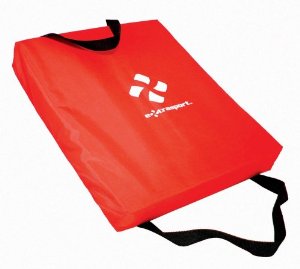Personal Flotation Devices (PFDs)
The U.S. Coast Guard and Wisconsin law require vessels under 16 feet in length to be equipped with one Type I, Type II, Type III or Type V personal flotation device, commonly called a life jacket, for each person on board. This means that even canoes and kayaks must carry a wearable PFD for each person on board.
Vessels 16 foot or more in length must be equipped with one Type I, Type II, Type III or Type V for each person on board plus at least one Type IV throwable for the boat.
In order to be an acceptable, each PFD must be:
- U. S. Coast Guard approved.
- In good condition, which means no tears, rips, broken straps or snaps. Use a squeeze test on kapok PFDs to check for punctures in the inner plastic liner.
- Of a suitable size for the intended wearer.
- Readily accessible. This means it may not be stowed in plastic bags, in locked or closed compartments or under other equipment.
Please note that Type V PFDs do not meet the PFD carriage requirements unless they are worn.
PFDs come in a variety of shapes, colors, and materials. Some are made to be more rugged and last longer while others are made to also protect the wearer from cold water. No matter which PFD you choose, be sure to get one that's right for you, your planned activities, and the water conditions you expect to encounter. Always look for the United States Coast Guard approval number on any PFD you buy.
Types of PFDs

Type I - off-shore life jacket - The Type I PFD provides the most buoyancy and is best for open, rough or remote water, where rescue may be slow in coming. It is designed to turn most unconscious wearers face-up in the water. The Type I comes in both adult and child size.

Type II - Near-shore buoyant vest - The Type II PFD is good for calm, inland water or where there is a good chance of quick rescue. This type will turn some, but not all, unconscious wearers face-up in the water. Less bulky than a Type I PFD, the Type II is the least expensive type of PFD. It is available in many sizes.

Type III flotation aid- The Type III PFD is good for calm, inland water or where there is a good chance of quick rescue. Designed to keep the wearer in a vertical position, it may require the wearer to tilt their head back to avoid going face-down in the water and therefore is not recommended for extended survival in rough water. The Type III allows more freedom of movement for active water sports and is generally the most comfortable type for continuous wear. Float coats, fishing vests, and vests designed with features suitable for various sports activities are examples of this type of PFD.

Type IV throwable device - The Type IV PFD is an approved device that is designed to the thrown to a conscious person in the water. This device is not designed to be worn and must have at least 16.5 pounds of buoyancy. These usually take the shape of a boat cushion, life ring, or horseshoe device. These devices must be readily accessible during boat operation.

Type V - special use device or hybrid inflatable - The Type V PFD is a special use device intended for a certain activity and may be carried instead of another PFD, but only if used in accordance with its label. Some of these devices provide hypothermia protection while others, such as a work vest, are intended for freedom of movement. A Type V may also take the form of hybrid inflatables such as float coats which combine inherently buoyant material with an inflatable bladder for extra lift. Type V PFDs must be worn when underway to be legal.

Inflatable PFDs - Inflatable PFDs come in Types I, II, and III. Although the different "Types" of inflatable PFDs are intended for use in the same areas as inherently buoyant types of PFDs, the characteristics of inflatable PFDs are different. Inflatable PF's are not inherently buoyant and will not float without inflation. For Types I, II, and III inflatables, the lower the Type number, the better the PFD's performance (e.g., Type I is better than Type II).